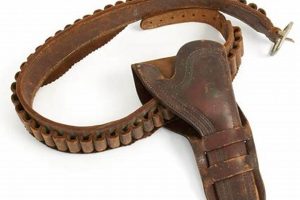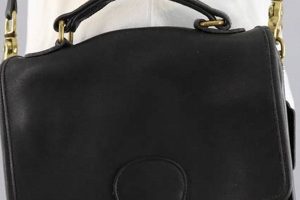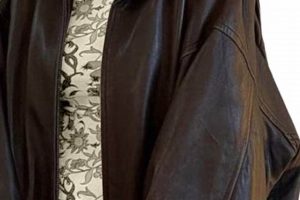Early protective headgear utilized in American football, crafted from tanned animal hide, represents a bygone era of the sport. These relics, predating modern polycarbonate helmets, offered minimal padding and coverage, primarily designed to prevent lacerations rather than mitigate concussions. They exemplify the evolution of safety standards within a physically demanding athletic pursuit.
These pieces of equipment hold considerable historical significance. They provide tangible links to the formative years of organized football, reflecting a different approach to player safety and a stark contrast to the advanced technology employed today. Furthermore, these items have become highly sought-after collectibles, prized for their aesthetic qualities and the historical narrative they embody, often commanding significant value within the memorabilia market. Their contribution lies in illustrating the development of athletic gear.
The subsequent sections will delve into the manufacturing processes, materials used, notable manufacturers, methods of preservation, and the considerations involved in acquiring and evaluating the authenticity of this specific type of sporting artifact.
Tips for Appreciating and Preserving Antiquated Football Headgear
The following guidelines are presented to assist in the proper handling, preservation, and assessment of historical leather football headgear. Adherence to these principles can help maintain the integrity and value of these artifacts.
Tip 1: Inspect for Structural Integrity: Prior to handling, carefully examine the item for signs of deterioration, such as cracking, dryness, or separation of the leather. Unstable components should be handled with extreme caution to prevent further damage.
Tip 2: Control Environmental Conditions: Store the headgear in a stable environment with controlled temperature and humidity. Fluctuations can accelerate the degradation of organic materials. Ideal conditions include a temperature between 65-70F and a relative humidity of 45-55%.
Tip 3: Avoid Direct Light Exposure: Prolonged exposure to ultraviolet (UV) radiation can cause fading and weakening of the leather. Display the item in a location away from direct sunlight or use UV-filtering display cases.
Tip 4: Use Acid-Free Materials for Storage: When storing, use acid-free tissue paper and archival-quality boxes to prevent chemical reactions that can damage the leather. Avoid storing the item in plastic bags, as they can trap moisture.
Tip 5: Clean with Care and Sparingly: Avoid using harsh chemicals or abrasive cleaners. If cleaning is necessary, consult with a professional conservator or use a soft, dry cloth to gently remove surface dust. Do not saturate the leather with any liquids.
Tip 6: Document Provenance and Condition: Maintain detailed records of the item’s history, including its origin, previous owners, and any restoration work that has been performed. Document the current condition of the item with photographs and written descriptions.
Tip 7: Consider Professional Conservation: For significant damage or extensive deterioration, seek the expertise of a qualified conservator specializing in leather artifacts. Professional conservation can help stabilize the item and prevent further decay.
Proper storage, careful handling, and an understanding of the materials will help to preserve this headgear for future appreciation. These items represent a tangible connection to the historical evolution of sports and related safety equipment.
The subsequent sections will cover authenticating, sourcing, and purchasing these items.
1. Material Composition
The primary constituent of antiquated football headgear is vegetable-tanned leather. This specific tanning process, utilizing natural tannins derived from plant matter, imparted durability and pliability to the hide. The thickness and quality of the leather directly influenced the impact resistance and longevity of the headgear. Inferior leather, prone to cracking and disintegration, offered minimal protection and reduced the item’s lifespan. Conversely, thicker, well-tanned leather provided a modicum of cushioning and enhanced structural integrity. The presence of additional materials, such as wool felt for padding or metal rivets for reinforcement, further dictated the overall performance and resilience of the helmet.
Variations in leather quality and tanning methods across different manufacturers and eras impacted the headgear’s performance characteristics. Some manufacturers employed superior tanning processes, resulting in leather that remained supple and durable for extended periods. Others opted for cheaper, less effective methods, leading to premature degradation. The presence of specific dyes or finishes also played a role in the leather’s resistance to moisture and wear. For example, helmets used in rainy conditions often exhibited accelerated deterioration due to the leather’s inability to repel water effectively. Furthermore, the type of stitching or lacing used to assemble the helmet contributed to its overall strength and resistance to tearing upon impact. Therefore, materials define its physical characteristics and subsequent protective capabilities.
Understanding the composition of antiquated leather football headgear is crucial for preservation efforts and authentication. Identifying the type of leather, tanning process, and supplementary materials allows conservators to implement appropriate cleaning and storage techniques. Similarly, examining the materials can help distinguish genuine artifacts from reproductions. The presence of synthetic materials or modern tanning agents indicates a non-authentic item. Therefore, the study of the material composition is central to appreciating these artifacts.
2. Manufacturing Techniques
The production of early football headgear involved labor-intensive, predominantly manual processes. Tanning the hide was the initial stage, transforming raw animal skin into a durable leather material. Subsequently, patterns were manually traced and cut, forming the individual pieces of the helmet. These components were then sewn together, often by hand or with early sewing machines, creating the helmet’s basic structure. Padding, typically consisting of wool felt or layers of leather scraps, was added to provide a degree of cushioning. Finally, hardware such as straps, buckles, and metal rivets were attached to secure the helmet and enhance its structural integrity. The precision and skill of the craftsmen significantly impacted the quality and protective capabilities of the finished product.
Variations in manufacturing techniques across different eras and manufacturers led to significant differences in helmet design and performance. Early models often featured minimal padding and rudimentary construction, offering limited protection against impacts. As the sport evolved, manufacturers experimented with different leather thicknesses, padding materials, and fastening systems to improve safety. For instance, some helmets incorporated multiple layers of leather or strategically placed padding to absorb shock. Others utilized adjustable straps to ensure a more secure and customized fit. These advancements reflected a growing awareness of the need for improved player protection, albeit within the limitations of available materials and technology. These differences highlight the manufacturing era it self.
The study of manufacturing techniques provides crucial insights into the historical development and authenticity of antiquated football headgear. Examining the stitching patterns, hardware details, and construction methods can help determine the age and origin of a helmet. Furthermore, understanding the techniques employed allows collectors and conservators to assess the item’s condition and implement appropriate preservation measures. Identifying flaws or inconsistencies in the manufacturing process can also reveal potential repairs or alterations, affecting the item’s value and historical significance. The evolution of manufacturing thus reflects advancements (or lack thereof) in player protection, impacting collectible value.
3. Era of Use
The period during which protective headgear was actively employed on the gridiron fundamentally shaped its design, materials, and overall effectiveness. The correlation between the era of use and the characteristics of the gear is substantial. For example, helmets from the 1900s-1920s, a time characterized by limited regulations and a focus on bare-bones protection, typically feature minimal padding and basic construction. As football evolved, and an awareness of player safety grew, the headgear developed accordingly. Each period reflects an adjustment to the sport’s challenges and the available technology.
Consider the impact of rule changes on design. When forward passes were legalized, altering the frequency and nature of collisions, improvements in headgear construction became more urgent. The advent of more sophisticated materials and manufacturing techniques led to helmets with increased padding, enhanced suspension systems, and more robust shells. These developments are traceable through the evolutionary timeline of football itself. Similarly, increased understanding of head injuries and concussions influenced further design changes, leading to experimentation with different impact-absorbing materials and helmet shapes. Recognizing the timeframe in which the equipment was utilized is therefore essential for a nuanced understanding of its design and purpose.
In summary, the historical period within which the headgear was actively used served as a catalyst for advancements and modifications. Understanding the timeframe not only aids in authenticating items but also provides vital context for interpreting the level of protection afforded and the cultural attitudes towards safety during that particular epoch in football history.
4. Protective Capability
The fundamental purpose of any athletic headgear is to mitigate injury, but the protective capability of aged leather football helmets is markedly different from that of modern equipment. Early models provided a limited degree of protection, primarily against lacerations and scalp abrasions, as opposed to the more comprehensive impact absorption afforded by contemporary designs. The cause for this disparity lies in the rudimentary materials and construction techniques employed during their production. Vegetable-tanned leather, while durable, possesses limited shock-absorbing properties compared to modern polycarbonate shells and energy-absorbing foam liners. The importance of understanding this distinction is paramount, particularly for collectors and historians seeking to contextualize the role these items played in the evolution of player safety.
Real-life examples underscore the limitations of such vintage equipment. Anecdotal evidence and historical accounts document instances where players sustained significant head trauma despite wearing these helmets, highlighting their inadequacy in preventing concussions and other severe injuries. In contrast, modern helmets undergo rigorous testing to meet stringent safety standards, offering substantially greater protection against a wider range of impact forces. However, the historical value is the representation of a specific era in football. Early helmets provide a glimpse into a time when player safety was not as prioritized.
In summary, the protective capability of early leather football headgear must be understood within the historical context of its creation. While they represent an important step in the evolution of athletic safety equipment, their practical limitations are undeniable. Recognizing these limitations is critical for accurately assessing their role in the history of football and for avoiding any misinterpretation of their effectiveness in preventing injuries.
5. Aesthetic Design
The visual appeal of antiquated leather football headgear holds considerable significance, extending beyond mere functionality. These items possess distinct aesthetic qualities that reflect the design sensibilities of their respective eras, contributing to their collectibility and historical value.
- Shape and Form
The silhouette of the helmet, ranging from the early, simple skullcaps to later models with extended ear flaps and rudimentary face guards, is a primary element of aesthetic design. The shape reflects not only evolving protective needs but also prevailing stylistic trends. Early forms prioritize basic coverage, while later designs incorporate features intended to enhance both protection and visual appeal. Real-world examples, such as the transition from the rounded helmets of the 1920s to the more streamlined designs of the 1940s, illustrate this evolution. These forms are an aspect of aesthetic values.
- Color and Patina
The natural hues of tanned leather, often ranging from light tan to dark brown, contribute to the helmet’s visual character. The development of a patina over time, resulting from exposure to the elements and handling, adds depth and complexity to the surface appearance. Uniform coloring indicates a more recent reproduction.
- Hardware and Detailing
The presence of buckles, straps, and stitching patterns enhances the headgear’s aesthetic design. These elements, often crafted from metal or leather, contribute to the overall visual texture and provide insights into the manufacturing techniques of the period. The presence of manufacturer’s logos or team insignias further enhances the aesthetic appeal and historical value. The arrangement and quality of these is a contributing factor to aesthetic merit.
- Construction Style and Detailing
The presence of buckles, straps, and stitching patterns enhances the headgear’s aesthetic design. These elements, often crafted from metal or leather, contribute to the overall visual texture and provide insights into the manufacturing techniques of the period. The presence of manufacturer’s logos or team insignias further enhances the aesthetic appeal and historical value. The arrangement and quality of these features contributes to aesthetic merit.
The aesthetic design of antiquated leather football headgear offers a valuable lens through which to examine the cultural and technological evolution of the sport. These design elements contribute to the overall appeal, historical value, and collectibility of these artifacts.
6. Collector's Value
The monetary worth ascribed to early protective headgear is contingent upon a confluence of factors that extend beyond its original function. Understanding these determinants is critical for assessing the investment potential and historical significance of these artifacts.
- Rarity and Scarcity
The limited availability of certain models due to low production numbers, preservation challenges, or historical circumstances significantly impacts their value. Helmets manufactured by lesser-known companies or those associated with specific, short-lived eras of football are often highly sought after. For example, a helmet produced for a regional team in the early 20th century may command a premium compared to mass-produced models from more prominent manufacturers.
- Condition and Authenticity
The physical state of the headgear, including the presence of original components, the absence of significant damage, and the verification of its genuine origin, plays a pivotal role in determining its collectibility. Helmets in pristine condition, retaining their original straps, padding, and manufacturer’s markings, are generally more valuable. Independent authentication from reputable experts further enhances the item’s desirability and market price. This validates its place in the collector world.
- Historical Provenance
A documented history connecting the headgear to a notable player, team, or event substantially elevates its worth. Helmets worn by Hall of Fame inductees or used in championship games are particularly prized by collectors. Verifiable documentation, such as photographs, letters, or game programs, can significantly increase the item’s appeal and market value.
- Aesthetic Appeal
The visual characteristics of the headgear, including its design, patina, and overall presentation, contribute to its collectibility. Helmets with unique or distinctive features, such as unusual color schemes or elaborate embellishments, may be more attractive to collectors. The natural aging process, resulting in a desirable patina, can also enhance the item’s aesthetic value and market price.
These factors collectively determine the position of antiquated football headgear within the collectibles market. The convergence of rarity, condition, historical provenance, and aesthetic appeal influences both the intrinsic and monetary value of these artifacts, solidifying their place as sought-after items for collectors and enthusiasts alike. These aspects ultimately determine this helmet’s collectibility.
7. Historical Context
The historical framework within which early football headgear existed is paramount to understanding its design, purpose, and significance. This perspective illuminates the cultural, technological, and societal forces that shaped its evolution and subsequent role as a historical artifact.
- Early 20th Century Football Landscape
The formative years of American football, characterized by rule ambiguities, evolving playing styles, and a limited understanding of player safety, directly influenced the development of early headgear. These helmets arose from a need to mitigate superficial injuries rather than to prevent concussions, reflecting the rudimentary medical knowledge of the time. The leather helmet thus symbolizes the early stages of a sport grappling with its own physicality and the inherent risks involved. For example, the “flying wedge” formation, a dangerous but popular tactic, led to increased head-to-head collisions, spurring the initial adoption of rudimentary head protection.
- Technological Limitations and Material Availability
The materials and manufacturing techniques available at the time significantly constrained the design and effectiveness of early football headgear. Vegetable-tanned leather, while durable, offered limited impact absorption compared to modern materials. The lack of advanced plastics and foam padding further restricted the ability to create helmets that could effectively dissipate energy. The scarcity of resources and the reliance on manual labor also impacted the production volume and affordability of these items. For example, the limited use of metal reinforcements in early helmets stemmed from both material constraints and the difficulty of mass production.
- Evolution of Safety Regulations and Player Awareness
The gradual implementation of safety regulations and the growing awareness of head injuries played a crucial role in the evolution of football headgear. As the sport became more formalized, and as the understanding of concussions and chronic traumatic encephalopathy (CTE) increased, manufacturers began to incorporate more advanced safety features into their designs. The transition from rudimentary leather helmets to more sophisticated models with padding and suspension systems reflects a shift in attitudes towards player safety. The establishment of organizations like the National Operating Committee on Standards for Athletic Equipment (NOCSAE) further spurred the development of safer helmets.
- Cultural Significance and Nostalgia
Antiquated leather football headgear holds a significant place in the cultural memory of American football. These items evoke a sense of nostalgia for a bygone era, representing a time when the sport was perceived as simpler and perhaps more rugged. They serve as tangible reminders of the sport’s origins and the evolution of athletic culture. The iconic image of leather-helmeted players battling on the gridiron has become ingrained in the American psyche, contributing to the collectibility and historical value of these artifacts. They represent an early aspect of football history.
These contextual elements underscore the interconnectedness between the “vintage leather football helmet” and the broader historical narrative of American football. Appreciating this framework enables a deeper understanding of the object’s significance, moving beyond its mere function as a piece of equipment to recognize its role as a cultural symbol and a testament to the evolving landscape of sports.
Frequently Asked Questions
The following addresses prevalent inquiries concerning historical leather football headgear. The information provided aims to offer clarity on various aspects, from preservation to authentication.
Question 1: How should a vintage leather football helmet be properly stored to prevent deterioration?
Optimal storage involves a stable environment characterized by controlled temperature and humidity. Direct sunlight exposure should be avoided, and the artifact should be housed in acid-free materials. Regular monitoring for signs of cracking or dryness is recommended.
Question 2: What are the key indicators of authenticity for vintage leather football helmets?
Authenticity indicators include the type of leather, stitching patterns, hardware details, and manufacturer markings. Consultation with a qualified expert is advisable for definitive authentication.
Question 3: Can vintage leather football helmets be safely restored or should they be left in their original condition?
Restoration decisions should be made cautiously. While some conservation efforts can stabilize the artifact, over-restoration can diminish its historical value. Seeking professional advice is essential.
Question 4: What cleaning methods are appropriate for vintage leather football helmets?
Harsh chemicals and abrasive cleaners are strictly prohibited. Gentle removal of surface dust with a soft, dry cloth is the recommended cleaning method. Avoid saturating the leather with any liquids.
Question 5: How did the design of vintage leather football helmets evolve over time?
Early models featured minimal padding and basic construction. As the sport evolved, manufacturers incorporated more advanced safety features, such as additional padding and improved fastening systems. Examining different models reveals this design progression.
Question 6: What is the typical range of collector’s value for vintage leather football helmets?
Collector’s value varies widely depending on factors such as rarity, condition, historical provenance, and aesthetic appeal. Prices can range from a few hundred dollars to several thousand dollars or more.
In summation, careful attention to preservation, authentication, and historical context is crucial for appreciating these historical sporting artifacts. Professional consultation is recommended for complex issues.
The subsequent section will address case studies.
Concluding Remarks on Early Football Headgear
This exploration has traversed the multifaceted aspects of vintage leather football helmet. From its rudimentary protective capabilities and manufacturing techniques to its aesthetic design, historical context, and collector’s value, a comprehensive understanding emerges. The artifact embodies the evolution of a sport and the shifting paradigms of player safety. This examination revealed the interplay of historical context, technological limitations, and cultural significance influencing the design and appreciation of these items.
Continued research and preservation efforts are crucial to ensure that future generations can appreciate the historical significance of the vintage leather football helmet. Its value extends beyond mere nostalgia, serving as a tangible reminder of the sport’s origins and the enduring quest to balance athletic competition with player well-being. Further investigation into specific manufacturers, player endorsements, and the impact of rule changes promises to reveal even more profound insights into this essential piece of sporting history.







